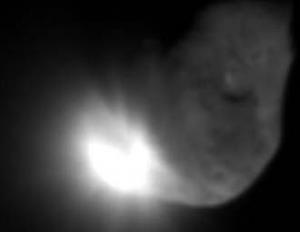Deep Impact gave mission scientists what they bargained for — and more– when its impactor collided with comet Tempel 1 last night. The collision occurred at 0152 EDT (0652 GMT), with the first image returning at 0157. Calling the impact ‘spectacular,’ principal investigator Dr. Michael A’Hearn of the University of Maryland, College Park added, “”With this much data we have a long night ahead of us, but that is what we were hoping for. There is so much here it is difficult to know where to begin.”
 Note the use of autonomous navigation aboard the impactor, which was released from the mothership at 0207 EDT (0607 GMT) on the 3rd. On its own, the impactor needed to make three targeting maneuvers as it closed on the comet, the first of these 90 minutes before impact, followed by two more at 35 and 12.5 minutes respectively. The result: a 10 kilometer per second collision with the comet, while the mothership monitored events from nearby, and legions of telescopes followed the action from Earth’s surface.
Note the use of autonomous navigation aboard the impactor, which was released from the mothership at 0207 EDT (0607 GMT) on the 3rd. On its own, the impactor needed to make three targeting maneuvers as it closed on the comet, the first of these 90 minutes before impact, followed by two more at 35 and 12.5 minutes respectively. The result: a 10 kilometer per second collision with the comet, while the mothership monitored events from nearby, and legions of telescopes followed the action from Earth’s surface.
Image: The initial ejecta that resulted when NASA’s Deep Impact probe collided with comet Tempel 1 at 10:52 p.m. Pacific time, July 3 (1:52 a.m. Eastern time, July 4) . It was taken by the spacecraft’s medium-resolution camera 16 seconds after impact. Credit: NASA/JPL-Caltech/UMD.
After some 14 minutes of data collection, the flyby probe entered ‘shield mode,’ in which its dust shields were set to protect instrumentation during its closest passage by the comet. Normal communications were re-established when shield mode ended at 0232 EDT. “The flyby surviving closest approach and shield mode has put the cap on an outstanding day,” said Deep Impact project manager Rick Grammier of the Jet Propulsion Laboratory. “Soon, we will begin the process of downlinking all the encounter information in one batch and hand it to the science team.”

